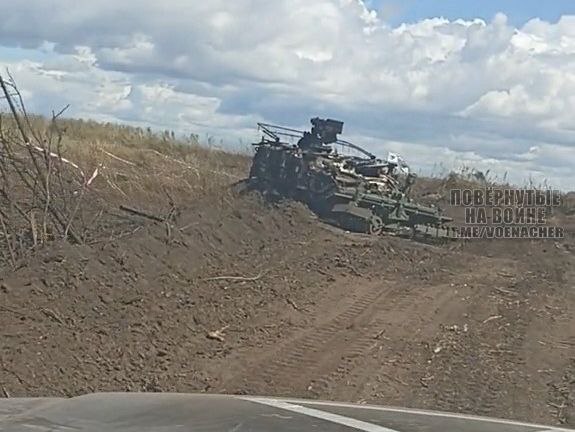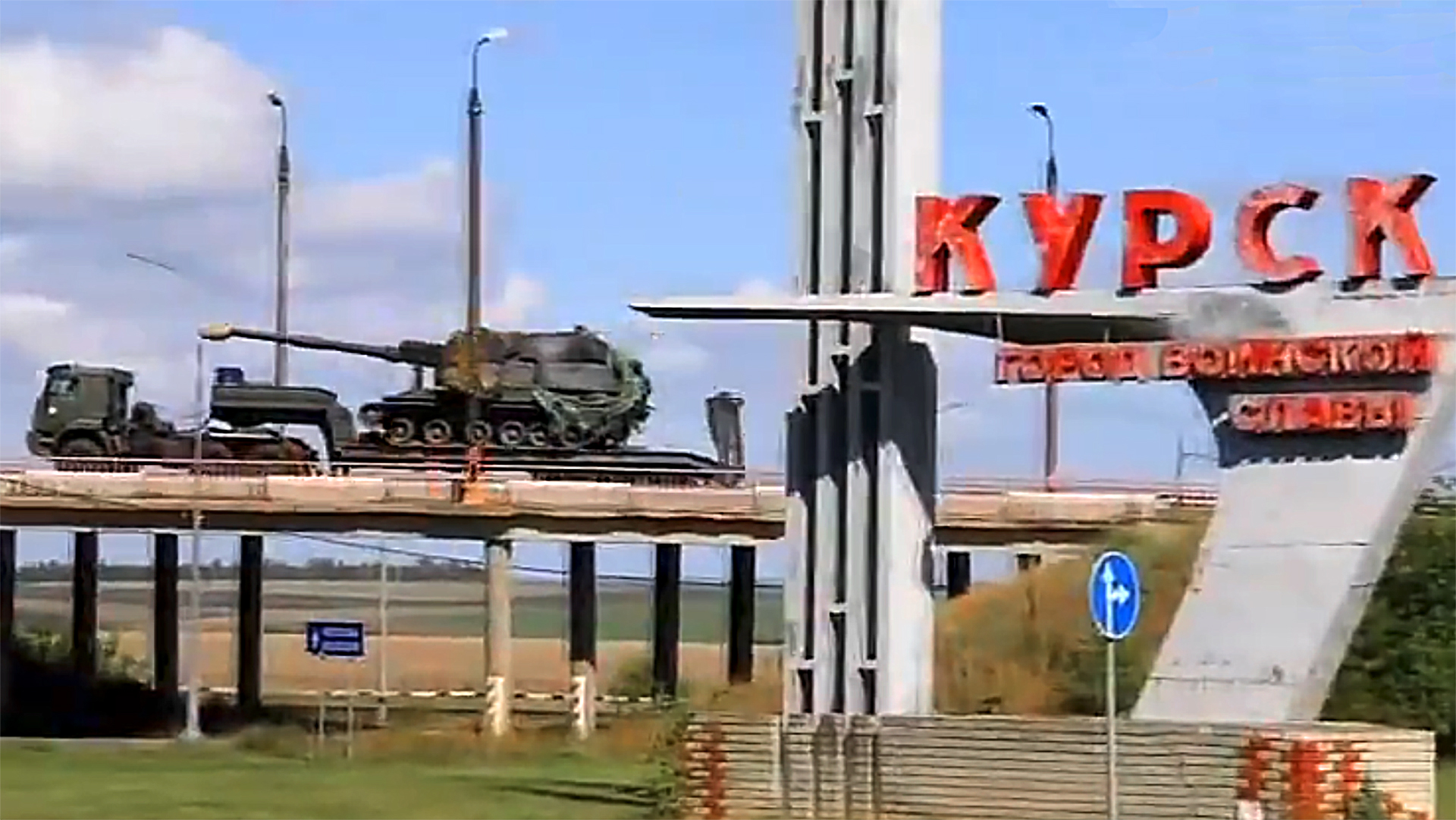Russia is rushing columns of troops and equipment to Kursk Oblast to fend off a Ukrainian invasion it originally claimed four days ago it successfully repelled.
Video has emerged on social media, some of it provided by official Russian news outlets, showing armored vehicles, multiple launch rocket systems (MLRS) and trucks full of soldiers racing to reinforce the region. For Moscow, the situation in Kursk has deteriorated to the point where the Russian Ministry of Emergency Situations declared a federal emergency on Friday, the official Russian RIA Novosti news outlet reported on Telegram. Such emergencies are declared by Russia when there are more than 500 victims or damage exceeds 500 million rubles (about $6 million), according to The Associated Press.
Despite the federal emergency, the Russian Defense Ministry (MoD) continued to paint an optimistic picture of the situation.
“The Sever Group of Forces continue to repel attempts of the Armed Forces of Ukraine to invade the territory of the Russian Federation in Kursk direction,” the Russian MoD proclaimed Friday on Telegram. “Army aviation strikes and artillery fire are foiling raid operations of the enemy targeting the depth of the Russian Federation.”
In contrast to Russia’s frequent claims of being near victory, Ukrainian officials continue to avoid providing any direct comment about the situation, though one unit on Friday posted video from inside Kursk (more on that later). President Volodymyr Zelensky also hinted at it in his address to the nation Thursday night.
“Russia brought the war to our land, and it should feel what it has done,” Zelensky said, without mentioning the Kursk invasion. “We strive to achieve our goals as soon as possible in peacetime – under just peace conditions. And it will happen.”
As has been the case ever since Ukraine launched this attack, solid information remains hard to come by.
The column of Russian forces was reportedly headed to Sudzha. That town, about six miles from the border, was one of the first targets of a mechanized invasion Ukraine launched with thousands of troops backed by tanks and other armor pouring over the border. Ukrainian troops “captured the Sudzha gas metering station, through which gas is transited to Europe through the territory of the so-called Ukraine,” the Russian Turned On Z War Telegram channel stated Aug. 7
The status of that city is unclear and even more so after Russian reinforcements began to arrive, according to Russian Telegram channels.
“At no point in the offensive since August 6 did the enemy fully control Sudzha,” Boris Rozin, who writes under the influential Colonelcassad Telegram channel said on Friday. “The city was operationally surrounded by midday on August 7, due to the fact that mobile enemy groups that had slipped past the city began firing at cars on the highway, establishing local fire control over the roads….”
After “the entry of the ‘Aida’ group and other units of the Russian Armed Forces (which are still working there) into the city, Sudzha is completely uncontrolled by anyone, there are some floating zones of control due to the limited forces in this area on both sides. In the city itself, meanwhile, since August 6, the presence of our military has remained, who for one reason or another did not withdraw from the city until the appearance of mobile enemy groups in the area of the roads leaving the city.”
“Today, the situation in the Sudzha area remains difficult, as well as in the city itself,” ColonelCassad continued. “Our specialists are working, this is not an easy job, but there are already successes, the enemy continues to suffer painful losses in the Sudzha area. It is necessary to increase the destruction of identified enemy targets, reducing the time from receiving target designation to the strike by the Aerospace Forces or UAV operators.”
Ukraine’s 61st Brigade, however, claimed the city is under the control of Ukrainian forces and posted a video they says shows them in the district’s center.
Russia’s efforts to bulk up its forces in the region have come under fire both literally and figuratively.
On Thursday, we told you that a large column of Russian troops was apparently struck by U.S.-donated M142 High Mobility Artillery Rocket Systems, or HIMARS on a Russian military column in the Ryslk District of Kursk. That’s about 20 miles due east of Ukraine’s Sumy Oblast.
The initial video, as we noted, showed the column engulfed in flames. Today, video emerged showing its aftermath. More than a dozen vehicles, many burned, some filled with apparently dead and possibly injured troops, lined the roadway.
By at least one estimate, more than two dozen troops of the 2nd motorized rifle battalion of 22nd Motorized Rifle Regiment were killed and 100 more were injured. The War Zone cannot independently verify those figures.
The issue of how Russia moves troops became a lightning rod for criticism Friday after a crew from the official Russian TV Zvedva recorded a column on the move not far from where the other one was hit.
“In the morning in the same Kursk region, there were shots of the aftermath of a convoy being hit,” the Kremlin-connected Rybar Telegram channel wrote on Friday. “And literally a couple of hours later another convoy in the same region was filmed not by an enemy informant, but by an ordinary Russian correspondent. Is it worth saying that this does not contribute to public trust in the Ministry of Defense?”
The person who filmed the column in flames was arrested by Russian authorities and accused of spying.
The influential Russian Thirteenth Telegram channel called for the reporter to receive the same fate.
“And why wasn’t the journalist arrested for filming a military column?” Thirteenth wrote. “There were some civilians arrested in the Kursk region.”
Beyond the issue of recording the convoys, some raised the question of how they are being operated. One Ukrainian Telegram channel noted that the video was reminiscent of scenes from the beginning of the war when Russia operated long convoys that got bottled-necked and became turkey shoots for Ukraine.
“Most importantly, as we approach the front, it is better to split the columns (including during stops, avoiding crowding of equipment and personnel), so as not to lose too much equipment and people at once in the event of missiles landing,” Colonelcassad explained. “The enemy will certainly try to inflict additional damage on us when moving reserves, which he of course tracks (including with the help of NATO satellites) and it is worth remembering that strikes can be without video.”
Another prominent Russian milblogger suggested that one method Ukraine may be using to track Russian troop movements is hacking into roadway camera systems.
“An important problem that needs to be solved urgently,” Yuri Podolyaka, a popular Ukrainian-born pro-Russian military blogger, wrote Friday on Telegram. “I just drove along the highway from Rylsk to Kursk via Lgov, the road is in working order, there is traffic on it, although the enemy is trying to bypass Korenevo in order to cut off this artery.”
Podolyaka said he noticed cameras working all along the highway.
“I personally am not sure that the enemy does not have access to these cameras and does not track the movement of our equipment through road cameras and surveillance cameras,” he wondered. “I wouldn’t be surprised if the column was broken up by them and spotted…We need to cut everything down if it doesn’t exist already.”
There are also claims that Russians have gained access to cameras in houses in Kursk being used to track the movement of military equipment.
In addition to taking losses on the ground, Russia reportedly lost another helicopter to a Ukrainian drone over Kursk.
“A first-person-view (FPV) drone operated by the Security Service of Ukraine (SBU) hit another Russian military helicopter in mid-air in Kursk Oblast,” a source in the agency told the Kyiv Independent on Aug. 9.
Ukraine is also taking significant losses.
This image shows a destroyed U.S.-donated M1132 Stryker ESV (Engineer Support Vehicle) armored vehicle with a Ukrainian Armed Forces LWMR light roller trawl on it.

By Friday morning, Ukraine had reportedly seized about 430 square kilometers of territory from Russia. Ukrainian troops are said to be fighting near the town of Kornevo, some 15 miles north of the border and less than 40 miles from the Kursk Nuclear Power Plant.
The mayor of Kurchatov, home to that nuclear plant, on Friday urged his citizens to remain calm even though fighting was getting closer.
“There are military actions several dozen kilometers from the borders of our city,” Igor Korpukkov wrote on Telegram. “The situation is tense, a state of emergency is in effect. However, all services, enterprises, including the city administration are working as usual.”
Depending on the pace of the advance, a source with direct knowledge of the operation told The War Zone that Ukrainian troops might try to take over the plant, akin to what Russia did with the Zaporizhzhia Nuclear Power Plant, which Russia captured in March 2022.
“Ukrainian troops are getting closer,” to the Kursk Nuclear Power Plant, said the source, speaking anonymously to discuss operational details. Taking it over would make it harder for Russian forces to dislodge them, the source said.
Whether that happens though depends on the pace of the advance. One big danger Ukrainian forces face is being too dispersed and having Russia cut off its line of supply.
At this point, we still don’t know exactly where Ukrainian forces are or how long they can hold out as Russia pours more troops and combat equipment into the fight.
Update: 9:40 PM Eastern –
In the wake of Ukraine’s surprise invasion, Russia’s National Anti-Terrorism Committee (NAC) issued a sweeping Counter-Terrorism Operations (CTO) order in Belgorod, Bryansk and Kursk oblsts.
The CTO was enacted due to “casualties among the civilian population, the destruction of residential buildings and other civilian objects,” NAC said, according to the Meduzza news outlet.
The decision was made by FSB Alexander Bortnikov, who chairs the NAC.
The goal is to ensure the safety of Russians and “suppress the threat of terrorist acts committed by enemy sabotage and reconnaissance units,” Meduzza reported.
According to Russia’s “On Counter-Terrorism” law, “a counter-terrorism operation is a set of special, operational-combat, military and other measures using military equipment, weapons and special means to suppress terrorist attacks, neutralize terrorists and ensure the safety of the population and organizations,” Meduzza noted.
During counter-terrorist operations, “local authorities are empowered to evacuate citizens and vehicles from specific areas, disconnect communication services, and monitor telephone conversations,” according to Meduzza. “Police officers executing anti-terrorism measures are granted the right to enter all premises without a search warrant.”
Since launching the full-scale invasion of Ukraine, officials have declared counter-terrorist operations twice before, according to Meduzza.
The first time was in the Belgorod region in May 2023 when the far-right paramilitary Russian Volunteer Corps raided several towns. The second time was in the Moscow and Voronezh regions in June 2023 when Wagner Private Military Company leader Yevgeny Prigozhin launched his putative putsch against the Russian Defense Ministry.
Contact the author: howard@thewarzone.com
